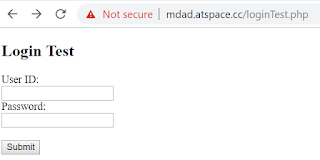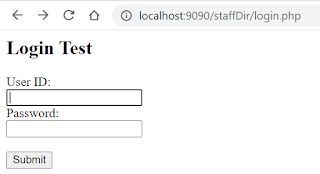WAMP server side (PHP)
Database
create table users( id int(11) primary key auto_increment, userid varchar(23) not null unique, password varchar(80) not null); /** Creating Users Table **/insert the data userid as 'abc' and password as 'def' for testing
PHP
Step1 :Create a db_connect.php
( Refer to Lab2)
Step2 :Create a login.php

<?php // check for post data if (isset($_POST["id"])) { $id = $_POST['id']; $pw = $_POST['pw']; // include db connect class require_once __DIR__ . '/db_connect.php'; // connecting to db $db= new DB_CONNECT(); $db->connect(); // get a product from products table $sqlCommand="SELECT * FROM users WHERE userid = '".$id."' and password ='".$pw."'"; $result =mysqli_query($db->myconn, "$sqlCommand"); //echo $sqlCommand; if (!empty($result)) { // check for empty result if (mysqli_num_rows($result) > 0) { echo ("Login Success"); } else { echo ("Login Failed"); } } else { echo ("Login Failed"); } } else { ?> <h2>Login Test</h2> <form action= "login.php" method="post"> User ID:<br> <input type="text" name="id" required> <br>Password:<br> <input type="password" name="pw" required> <br> <br> <input type="submit" value="Submit"> </form> <br> <?php } ?>
Step 3 :Run your Wamp server and test it
Step 4: If Login is successful, we want user to be able to see a link to
addProduct.php
Add in the codes highlighted in yellow at login.php:
if (mysqli_num_rows($result) > 0) {echo ("Login Success"); ?> <br> <a href= "addStaff.php">Add Staff </a> <br> <?php } else { echo ("Login Failed (No data)"); }
Step 5: Test it
Step 6: However, this is not the best solution.
If the user knows the deep link URL address for addStaff.php, the user can goto addStaff.php directly without login
E.g.
Step 6: we can use Session to prevent user to go to addStaff without Login.
Step 6A: We will modify login.php as follows:
Add one line session_start(); in the first line of PHP code after <?php
<?php
session_start();
// check for post data
if (isset($_POST["id"])) {
$id = $_POST['id'];
$pw = $_POST['pw'];
Add one line $_SESSION["loginKey"] = "ok"; to create a session variable name loginKey with a value "ok"
if (mysqli_num_rows($result) > 0) {
echo ("Login Success");
$_SESSION["loginKey"] = "ok";
Add in the codes highlighted in yellow at login.php:
This will auto forward the page back to login.php when login Failed.
else {
echo ("Login Failed");
?>
<meta http-equiv="refresh" content="0; URL='login.php'"/>
<?php
}
Step 6B: We will modify addStaff.php as follows:
We will get the $_SESSION["loginKey"] and store it in $login
$login = $_SESSION["loginKey"]
if no session variable $_SESSION["loginKey"], $login = "notOk";
<?php
session_start();
if (isset($_SESSION["loginKey"] ))
$login = $_SESSION["loginKey"] ;
else
$login ="notOk";
?>
<html>
<body>
Add the following codes for Logout,
On Logout it will auto forward to login.php
<meta http-equiv="refresh" content ="0; URL='login.php'" />
If user has not login before, we show a hyperlink for user to Login
if ($login <> "ok")
{
echo "<br><h1> <a href= 'login.php'> Please Login to select Class </a> </h1>";
}
if(isset($_GET['logout'])) {
// clear the session variable, display logged out message
session_destroy();
echo "<br><h1> Logout </h1>";
?>
<meta http-equiv="refresh" content ="0; URL='login.php'" />
<?php
}
else
if ($login <> "ok")
{
echo "<br><h1> <a href= 'login.php'> Please Login to select Class </a> </h1>";
}
else
// check for required fields
if (isset($_POST['name']) && isset($_POST['tel'])) {
$name = $_POST['name'];
$tel = $_POST['tel'];
Add a hyperlink Logout at the end of the code
<a href='addStaff.php?logout=1'>Log-out</a>
<h2>Add Staff</h2>
<form action="addStaff.php" method ="post">
Name:<br>
<input type="text" name="name" required>
<br>
Telephone Number:<br>
<input type="text" name="tel" required>
<br>
<br>
<input type="submit" value="Submit">
</form>
<a href='addStaff.php?logout=1'>Log-out</a>
</body>
</html>
<?php
}
?>
Step 7: Test it out
Step 8: SQL injection Test
"Hacked"
Your Login with SQL injection, we know the username but do not know the
password so we enter password as aaa' or
'1=1
Example
username : abc
password : aaa' or '1 =1
The SQL comand will becomes
SELECT * FROM users WHERE userid = 'abc' and password = 'aaa' or '1 = 1'
You
will find that SQL command written in such a way is easy to be hacked with SQL
injection
Step 9: Modify your code for login.php as shown below:
<?php session_start(); // check for post data if (isset($_POST["id"])) { $id = $_POST['id']; $pw = $_POST['pw']; // include db connect class require_once __DIR__ . '/db_connect.php'; // connecting to db $db= new DB_CONNECT(); $db->connect(); //SELECT * FROM users WHERE userid = 'abc' and password = 1 or "1 =1" // get a product from products table $sqlCommand="SELECT * FROM users WHERE userid = '".$id."'"; $result =mysqli_query($db->myconn, "$sqlCommand"); //echo $sqlCommand; $checkLogin =false; if (!empty($result)) { // check for empty result if (mysqli_num_rows($result) > 0) { foreach($result as $row) { if ($pw == $row["password"]) { echo ("Login Success"); $_SESSION["loginKey"] = "ok"; $checkLogin =true; ?> <br> <a href= "addStaff.php">Add Staff </a> <br> <?php break; } //end if }//end for if ($checkLogin==false) { echo ("Login Failed"); } }else { echo ("Login Failed"); ?> <meta http-equiv="refresh" content="2; URL='login.php'"/> <?php } } else { echo ("Login Failed"); } } else { ?> <h2>Login Test</h2> <form action= "login.php" method="post"> User ID:<br> <input type="text" name="id" required> <br>Password:<br> <input type="text" name="pw" required> <br> <br> <input type="submit" value="Submit"> </form> <br> <?php } ?>
Step 10: Test it out with SQL injection


No comments:
Post a Comment
Note: only a member of this blog may post a comment.